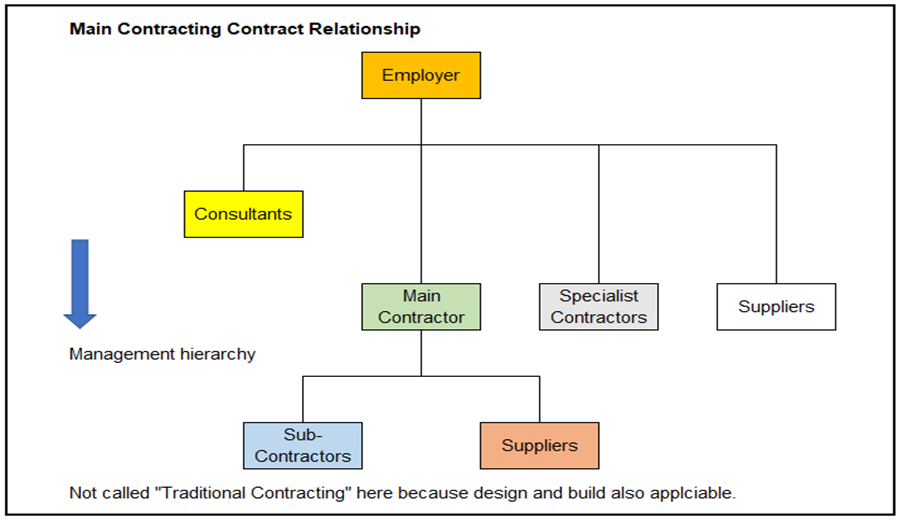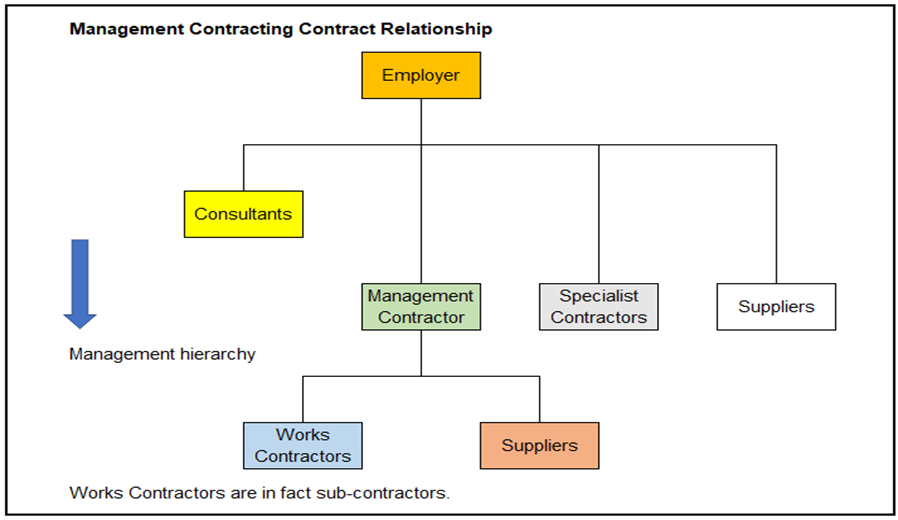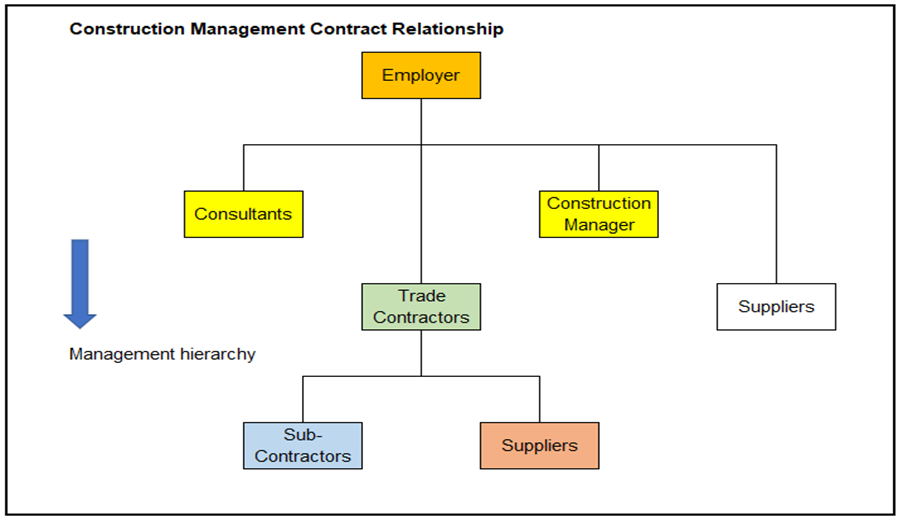Procurement Strategy 採購策略
Procurement Strategy 採購策略 KCTangNote 註
29/1/2024: Revised.
19/2/2023: Revised.
20/12/2014: Moved from wiki.
Intro 介紹
Need 需要
- Quantity Surveyors need to have knowledge to advise on the procurement strategy and contractual arrangement.
工料測量師需具備就採購策略和合約安排提供建議的知識。
(added, 19/2/2023)
Why contract out? Why call for tenders? 為什麼要外包? 為什麼要招標?
- Find someone to do it for you.
找人幫你做 - Someone:
該人:- More capable
較有能力 - Statutorily qualified
有法定資格 - Less costly.
成本較低
- More capable
- Accountability in case of joint venture.
合資企業的問責。
When to decide? 什麼時候決定?
- As early as when the first project programme is developed.
早在第一個項目計劃制定時。
Which types of contractual arrangement? 哪些類型的合同安排?
- Traditional or special? 傳統還是特殊?
Classification of contract types based on 不同的合同形式的分類
Contract scope 按承包範圍分類
- Design.
設計 - Build.
施工 - Design and build / turnkey / package deal / engineering, procurement and construction:
設計和施工 / 交鑰匙 / 統包 / 設計、採購和施工- 優點:
- 工程太簡單不必請建築或工程師。
- 取得承包方特有而一般的建築或工程師沒有的特殊設計優點。
- 取得承包方特有的建造方法或產品。
- 設計及施工時間可重疊,相應縮短了工期。
- 總的來說可省一些設計費。
- 由承包方單一負責,而減少多方參與責任不清的程度。有時這個好處被視為最大優點,使到根本不存在上述2及3點的工程都採用。
- 總造價較有保証。
- 可規定成品能滿足意向功能,此乃高於一般只需行使合理技能的標準。
- 在全包的情況下,承包方的索賠機會較少。
- 缺點:
- 發包方的要求寫得太死,承包方沒有自由設計的空間。
- 發包方的要求寫得太鬆,不能表達到預期的成果,或有空間給承包方索賠。
- 發包方不能隨意改動要求。
- 發包方對設計的改動要求,是屬於原要求範圍內還是超出範圍,往往會有爭議。
- 真的超出範圍而需計算增加費用時,因可能要與一個尚未設計好便改動了的方案比較,難度比較大。減內容亦有類似的問題。
- 鑑於總造價是基本封頂的,發包方會傾向在具體設計時增加內容及取最高的標準,令承包方吃虧。
- 鑑於總造價是基本封頂的,承包方會傾向在具體設計時盡量省料及取最低的標準,令發包方吃虧。
- 雙方合作不愉快時,爭議反為多了。
- 優點:
- Design, build and operate.
設計、施工、營運
Contract relationship 按承包關係分類
- Traditional main contracting.
傳統總承包 -
Management contracting.
管理承包
-
Construction manager.
施工管理經理



Pricing basis 按投標基礎分類
- Based on firm bills of quantities, with reference to drawings and specification.
按確定工程量清單,參閲圖紙及規範 - Based on provisional bills of quantities, with reference to drawings and specification.
按暫定工程量清單,參閲圖紙及規範 - Based on drawings and specification, without bills of quantities. Submitted as quotations / schedule of rates / schedule of quantities and rates / activities schedules.
只按圖紙及規範,不含工程量清單。以報價單 / 單價表 / 有量單價表 / 活動表提交 - Based on pre-priced schedule of rates, competing on adjustment percentages.
按預設單價表,競爭調整費率
Pricing nature 按標價形式分類
- Lump sum total, with unit rates.
總價報價,輔以單價 - Rates only, without total.
單價報價,無總價 - Percentage.
費率報價
Degree of risks 按風險程度分類
- Fixed price.
固定價 - Price with fluctuation.
可調價 - Cost plus fee (lump sum fee, fixed percentage fee, scaled percentage fee, sharing).
成本加服務費(一筆過、固定費率、遞減費率、分成) - Ceiling price / Guaranteed Maximum Price.
封頂價- Demarcation between Costs and Fee.
成本與服務費的劃分
- Demarcation between Costs and Fee.
Funding arrangement 融資安排
- All funded by the employer.
- 全由發包方安排
- Public-private partnerships:
公私營合作- Build–Operate–Transfer, BOT
民間興建營運後轉移模式 - Operate–Transfer, OT
營運後轉移模式 - Build-Operation-Own, BOO
興建-營運-擁有模式 - Reconstruction-Operation-Transfer, ROT
民間重建營運後移轉模式 - Private finance initiative (UK)
民間融資提案 - Private Sector Participation Scheme (HKHA)
私人機構參建居屋計劃 (居屋) (香港房屋委員會) - References:
- https://en.wikipedia.org/wiki/Public%E2%80%93private_partnership
- An Introductory Guide to Public Private Partnerships (PPPs) March 2008 (Second Edition) published by the Efficiency Unit of the Government of Hong Kong SAR
- Practical Guide to Public Private Partnership (PPP) Projects published 2009 by the HKIS
- Build–Operate–Transfer, BOT
Degree of commitment
- One-off contracts.
- Term contracts.
- Serial contracts.
- Standing offers.
- Framework contracts:
https://www.designingbuildings.co.uk/wiki/Framework_contract - Prime contracts:
https://www.designingbuildings.co.uk/wiki/Prime_contract
How to package contracts?
- Optimum balance between the time required to complete every design and the time required to construct.
- Optimum balance between single line responsibility and more control over choosing sub-contractors and suppliers.
- Specialist works by specialist contractors/sub-contractors.
- Responsibility for delivery time and wastage to be watched out if nominated supply contracts are used.
Usual contract packaging 總包分包的分拆
-
Site Survey Contract.
現場勘察合同
-
Ground Investigation Contract.
地質勘察合同
- Demolition Contract.
拆卸工程合同 - Piling Contract.
基樁合同 - Main Contract.
主合同 - Sub-Contract.
分包合同 - Supply Contract.
供應合同 - Other Direct Contracts.
其他獨立合同
Which form of contract?
- Private or public?
- Domestic or international?
- Standard form or specially drafted?
- Old or new versions?
- With how much amendments?
- How harsh?
- See Forms of Contract.
Risks sharing 風險的分擔
- Soil conditions.
土質 - Underground obstructions.
地下障礙物 - Phased possession of site and completion.
分階段交付工地及竣工 - Time for completion.
工期 - Liquidated damages.
誤期賠償 - Grounds for extension of time.
工期延長的許可原因 - Grounds for monetary claims.
索賠的許可原因 - Insurances and bonds.
保險及擔保 - Defects liability period / defects rectification period.
保修期 - Payment terms.
付款辦法
Guaranteed Maximum Price 封頂價
Guaranteed Maximum Price 封頂價 KCTang30/1/2024: Some typos corrected.
20/12/2014: Moved from wiki.
- What does “guaranteed maximum price” mean?
- It means the maximum price payable to the Contractor after completion of the Works and defects rectification.
- Who is to bear when the final price is more than the guaranteed maximum price?
- The Contractor.
- From the Contractor’s point of view, individual cost overruns must be allowed to be balanced by individual cost savings.
- Who is to gain when the final price is more than the guaranteed maximum price?
- The Employer.
- The Contractor may have a share.
- Why a guaranteed maximum price is required?
- The Employer wants certainty in budgetary control.
- When would a guaranteed maximum price arrangement be feasible?
- The design is not fixed yet such that the Contractor can design to stay within the guaranteed maximum price
- The design is complete but the Contractor can provide better alternatives.
- What kinds of employers would prefer a guaranteed maximum price contract?
- Non-professional developers and owners.
- Those who want certainty in budgetary control.
- Those who want to seek excellence in design and construction management.
- What types of contractors are qualified for a guaranteed maximum price contract?
- Those who have design expertise.
- Those who have site management team understanding the risks of guaranteed maximum price contract.
- Why are guaranteed maximum price contracts used more in the United States?
- The Contractor is on-board upon the inception of early design stage.
- The Contractor is responsible for the design or the development of design.
- The Architect only provides schematic design or design intent.
- When can the guaranteed maximum price be varied?
- What should constitute a Variation?
- “A material change in the nature, type, quality or quantity of any goods, materials or workmanship specified in the GMP Works Contract. A change to any work including advance preparation and procurement works which has been commenced or completed at the time the variation is issued. A change to any specified sequence, timing (including acceleration measures) or method of construction. Every case excludes Design Development.” ???
- What is design development?
- Development of the brief or design intent into working details for construction.
- “Any development or progress of the design of the Works from the state of the design set out in the Contract towards finalization in a form suitable for construction and includes the clarification, elaboration, supplementing and/or augmenting of any method statement, drawing, specification or any other document or thing pertaining to such design.” ???
- What is design development instruction?
- “Any Instruction issued by the Management Contractor to the GMP Works Contractor in relation to Design Development including the provision of drawings, details, or information necessary for the GMP Works Contractor to carry out and complete the Works which instruction shall not initiate an adjustment to the GMP and shall not constitute a Variation.” ???
- “The Design Development process shall not include the introduction of Variations as defined, such Variations shall only be ordered by GMP Instructions.” ???
- How should the Contractor tender and price for guaranteed maximum price contracts?
- Make sure that there is room for cost saving from the tendered design.
- How can the Contractor survive after tender award?
- Make sure that there is room for cost saving from the tendered design.
- Why is design development important to the Contractor?
- Put the design under the Contractor’s control to ensure that the final design, materials, workmanship and method would not exceed the guaranteed maximum price.
- Should the Contractor want the design details to be provided by the Architect?
- No, the chances are the Architect will want to perfect and upgrade the design such that the costs will become higher.
- How should the difference between a prime cost sum and its initial awarded sum or its final expenditure be treated?
- How should the guaranteed maximum price be adjusted for direct loss and/or expense, liquidated damages, acceleration, costs of defects rectification, and the Contractor’s alternative design proposals, provisional quantities, p.c. rates?
Demarcation between Costs and Fee
Demarcation between Costs and Fee KCTangNote
21/3/2024: NEC Schedules moved to here.
4/3/2024: NEC Schedules changed to table form.
29/1/2024: Updated to include NEC Schedules of Cost Components.
12/1/2018: Created.
Views written on 22 Aug 2005
For cost plus contracts, arguments can easily arise as to whether an expenditure should be treated as part of the reimbursable costs or part of the fees. Essentially those items which can be carried out by the head office of the Contractor rather than on site may be regarded as part of the office overheads and therefore as part of the fee rather than costs. Contractors would try to argue in reverse. Items which need careful descriptions in the cost plus contracts to avoid arguments include:
- Types and extent of design responsibilities.
- Types and number of head office supervisory, technical and clerical staff to be employed and deemed to be part of the fee.
- Types and number of supervisory, technical and clerical staff to be specifically provided for the Contract and chargeable as costs.
- Expenses in connection with sub-letting which can be done by the tendering and purchasing department of the Contractor at the head office or alternatively by a dedicated team, such as sourcing tenderers, preparing tender documents, inviting tenders, analysing tenders, preparing contracts.
- Types and extent of attendance of head office administrative nature rather than physical work upon sub-contractors and suppliers.
- Effects of fluctuations in the costs of labour, materials or plant, exchange rates of currencies, or Government taxes, fees and charges.
- Interests on money, finance charges, patent right and royalty.
- Entertainment expenses for customers and visitors, customary mid-year and year end gift expenses, expenses in connection with ceremonies at commencement of works, completion of works or part thereof, celebration and obituary offering expenses.
- Types and extent of taxes, fees or charges.
- Costs in connection with the obtaining of permits, approvals, consents from Government, local authorities and statutory undertakers.
- Import duties, custom clearance, administrative handling charges.
- Types and extent of usual preliminaries to be deemed to be part of the fee.
- Extent of Contractor's site office expenses including costs of stationery, paper, accounts, printing, fuels, office equipment.
- Site transportation vehicles including fuel charges, insurances and license fees.
- Extent of Contractor's communication expenses such as postal charges, telex, telegram, long distance calls, etc.
- Contra-charges imposed by the Builder for loading and unloading of materials, use of lifts and hoists, removal of rubbish, use of water and electricity, damage by one trade upon the other
- Acceleration and overtime to catch up programmes.
- Preparation of periodic reports and programmes.
- Taking of progress photographs.
- Provision of portable safety measures, first-aid kits.
- Accidental damage to utilities, roads and footpaths.
- Types and extent of protection, cleaning, rubbish removal and maintenance work during construction.
- Watchmen.
- Setting out team and responsibility.
- Types and extent of insurances. Deductibles under insurance policies.
- Types and extent of common plant, tools, etc.
- Extent of scaffolding, working platform at high levels, temporary supports, etc.
- Extent of hoardings, screens, protective covering to be provided.
- Establishment, operation and removal of storage sheds, workshops, offices, latrines.
- Off-site storage.
- Use of telephone, water and electricity. Provision of temporary plumbing, electrical installation, etc.